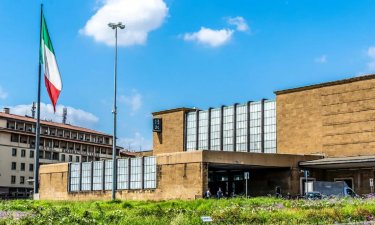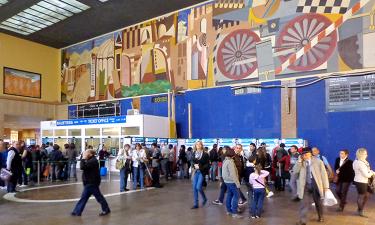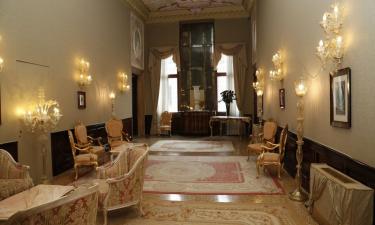From one of the most visited cities in Italy to a quiet gem: tips on taking the train from Florence to Verona.
Not far from Florence is Verona, an often-overlooked Italian city with a quiet charm. Known for its stunning Roman amphitheater and romantic "Juliet’s balcony", this small but sophisticated northern city is worth a visit.
The 145 miles (231 km) between Florence and Verona are easily covered by car along Italy’s major highways, but the historic center of Verona is quite compact and best visited on foot, so it is recommended to avoid the additional cost and hassle of a car, and take the train instead. In addition, if you are continuing on from Verona to Venice, you will not be allowed to bring your car to the Venetian islands.
Frequent Trains from Florence to Verona
Almost all of the 38 trains which run daily between Florence Santa Maria Novella station (also called S.M. Novella) to Verona’s Porta Nuova station are Trenitalia's high-speed Alta Velocità (AV) trains. Even though these trips involve a train transfer either at Bologna or Padua, the trip can take less than two hours on these AV trains. Trips that include a leg on the slower Regional trains can take up to 2.5 hours. Tickets for the train from Florence to Verona begin at about $29.
Italo trains run from Florence to Verona four times per day and take about 1.5 hours.
Trains run less frequently on weekends and holidays and can have longer travel times.
Direct Trains from Florence to Verona
There are no direct AV trains from Florence to Verona. All trips include a change in Bologna or Padua. Even though there is a transfer, you will generally always be on high-speed train, so the trip is still relatively short. You usually have anywhere from 15 minutes to half an hour to change trains.
Amenities on Trains from Florence to Verona
The fastest AV train is the Frecciarossa, and it is equipped with air-conditioned cars, monitors listing travel information and news, individual power outlets, WIFI, and 3g and 4g internet. There are different classes with color-coded cars. Executive class is brown, with meal service and station lounge. Business and Premium are blue and red, both providing a snack, drink and choice of newspaper to passengers. Standard is orange, with snack and drink service. A café car is also available to all passengers.
Frecciabianca, Frecciargento, and Eurocity trains are lower-tier AV trains, similar to the Frecciarossa but slower. These simpler trains have air-conditioned 1st-class and 2nd-class cars, and individual power outlets. First-class tickets include a free drink and newspaper, and all routes offer either a trolley service and/or a café car.
Regionale trains may include 1st-class and 2nd-class cars, though sometimes the entire train is 2nd-class. Passengers are not required to reserve a seat, so you may choose among the available seats in your class car. Regionale trains do not offer food service or a café car, and the air conditioning and power sockets may not always be functional.
Florence and Verona Train Stations
Florence's Santa Maria Novella station is just steps from the historic center and next to a major hub for local and regional buses, making it a very convenient station for travelers.
Note: the Florence Santa Maria Novella station currently has a security check before the platforms, so make sure to factor in a few extra minutes for the delay.
Porta Nuova is located on Piazzale 25 Aprile and is Verona’s main train station. The city’s hub for local and regional buses is adjacent, so you can easily catch the bus from the train station into the center of Verona.
Journey Information
See below for details on traveling from Florence to Verona by train.
Frequently Asked Questions (FAQs) About Train Travel in Italy
From seat assignments and luggage space, to the different types of tickets, here are some of the most frequently asked questions about train travel in Italy.
Arrival and Departure Train Destinations
Read on for information about Florence to Verona train stations.
Santa Maria Novella (SMN) Guide

The center of the Renaissance is also a popular Central Italy hub for rail connections.
Read More >>Verona Train Station

The primary train station in the Veneto city of Verona is Verona Porta Nuova, opened in 1852. The station was rebuilt twice, the second time because it was destroyed in World War II, and the current building dates from the late 1940s.
Read More >>Things To Do in Verona
Book tours and activities from nearby Venice

Exclusive Venice: Doge’s Palace and St. Mark’s Basilica Semi-Private Tour
Dive into the heart of Venetian splendor with a semi-private guided tour of St. Mark's Basilica and the Doge's Palace.
Book Now >>
Backstreet Bacari: Venice Food Tour
Discover the heart of Venice through its traditional "bacari" on a guided food tour.
Book Now >>Hotels in Verona
See Hotels from nearby Venice

Ca’ Sagredo Hotel
Live like royalty when you stay at the elegant and refined Ca’ Sagredo hotel; every part of the hotel evokes opulence. Don't miss the splendid terrace overlooking the Grand Canal and the Rialto markets.
Book Here >>
Corte di Gabriela Hotel
Tucked away off of a small street close to Campo Sant’Angelo, this boutique hotel is conveniently situated for easy access to the Rialto, Piazza San Marco and La Fenice Opera House.
Book Here >>